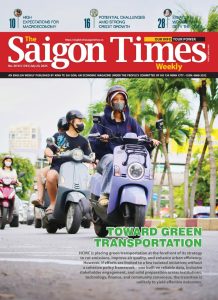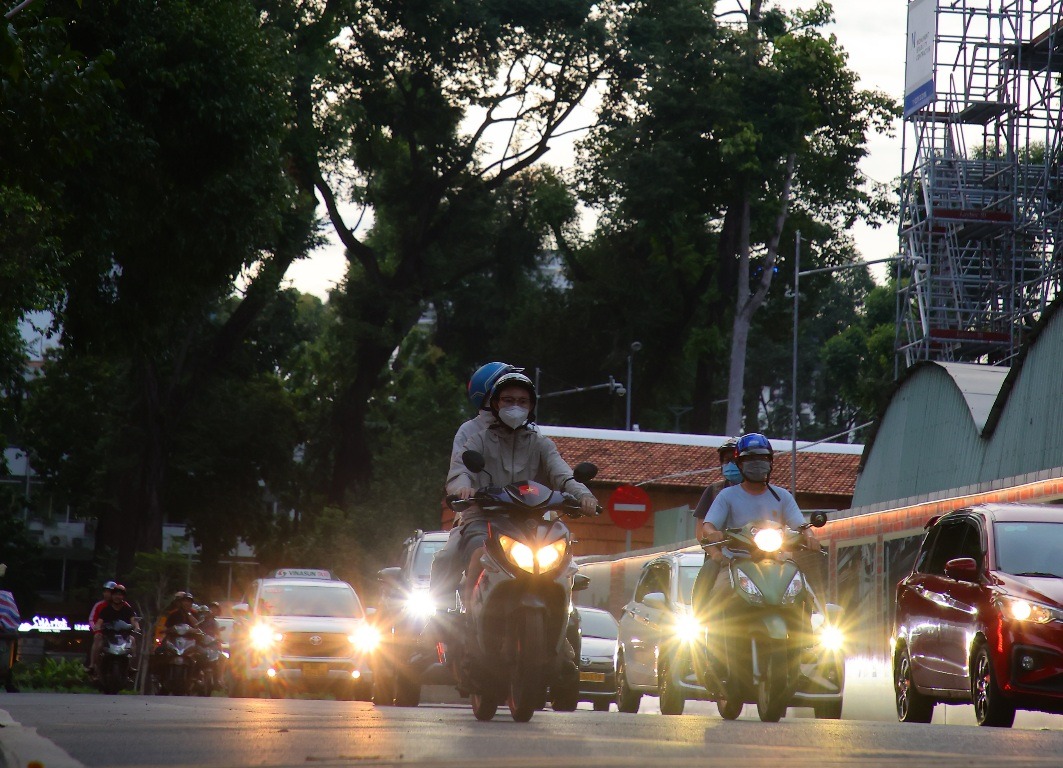HCMC is placing green transportation at the forefront of its strategy to cut emissions, improve air quality, and enhance urban efficiency. However, if efforts are limited to a few isolated initiatives without a cohesive policy framework – one built on reliable data, inclusive stakeholder engagement, and solid preparation across institutions, technology, finance, and community consensus, the transition is unlikely to yield effective outcomes.
This article draws on insights from an interview with Assoc. Prof. Dr. Bui Thi Mai Hoai, dean of Sustainable Finance Institute at the University of Economics HCMC.
According to data from the Southern Center for Environmental Monitoring (2024), transportation activities in HCMC (prior to the recent merger) emit over 13 million tons of CO2 annually, accounting for 99% of total local emissions, 78% of sulfur dioxide (SO2), and 75% of fine particulate matter (PM2.5). Alarmingly, PM2.5 levels in the city are more than four times higher than the safety limit recommended by the World Health Organization (WHO), posing serious health threats to the population. Air pollution is estimated to cause over 1,000 premature deaths in the city each year (*). Against this backdrop, shifting toward green transportation is not just a policy option; it is a critical move to protect public health and improve urban living standards.
A wide range of solutions…
When it comes to green transportation, many people immediately think of electric vehicles or buses powered by clean energy. But in reality, these are just the visible parts of a much broader concept – a sustainable transport ecosystem where emissions are curbed, congestion is managed, and everyone can access safe, efficient, and equitable transport options. Green transportation should be understood as a comprehensive effort to reduce pollution, lower public health risks, prevent traffic accidents, improve travel efficiency, and ease congestion – while also promoting the sustainable use of energy and resources, without compromising people’s livelihoods.
Assoc. Prof. Dr. Mai Hoai noted that there are multiple pathways for transitioning to green transportation.
Creating “nudges” in public policy – small adjustments in the decision-making environment – can significantly influence people’s travel behavior in a more environmentally friendly direction. This approach, rooted in Nudge Theory, suggests that instead of imposing bans or strict mandates, policies should be designed to make it easier for individuals to choose what is better for both themselves and society. For green transportation policies to be effective, there needs to be a well-balanced combination of “pull” and “push” factors. The “pull” comes from convenient infrastructure and high-quality public transport services, while the “push” involves economic measures such as taxes, fees, or regulations aimed at discouraging high-emission vehicles. Crucially, both types of measures must be grounded in a clear understanding of actual consumer behavior.
Building a public transportation network that is convenient, safe, affordable, and supported by well-designed tax and fee policies to discourage private vehicle use is a solution worth serious consideration. Hoai cites Singapore as a prime example: the country not only invests heavily in modern public transport infrastructure but also elevates the image of buses and trains, making them clean, punctual, accessible, and respectable modes of transport that reach every corner of the city. This allows residents to travel easily without relying on private vehicles. At the same time, the Singaporean Government uses financial tools, such as high taxes and fees on private cars, to incentivize a shift in mobility habits toward more sustainable choices.
Another solution lies in urban planning based on the “compact city” model, which aims to organize urban space more efficiently by reducing the distance between residential areas, workplaces, and essential public amenities. When key destinations are within walking or cycling distance, the demand for private vehicle use drops significantly. At the same time, this approach creates more favorable conditions for public transportation systems to operate efficiently.
Ensuring predictability in the integration of renewable energy into vehicle operations is also highly beneficial. A 2023 study (*) highlighted significant advancements in hydrogen fuel cell vehicle (Fuel Cell Electric Vehicles – FCEV) technology from improved fuel cell efficiency and fueling infrastructure development to reduced production costs. These improvements make FCEVs a viable option for medium- and heavy-duty vehicles – a segment where battery electric vehicles (BEVs), which rely on lithium-ion batteries, still face challenges related to weight, charging time, and limited driving range. While BEVs are better suited for personal cars and light trucks due to their high efficiency and increasingly advanced battery technology, FCEVs excel in driving range and are well-suited for freight transport and public transit. This distinction is critical when considering whether to invest heavily in widespread electric charging infrastructure, as some recent proposals suggest, Hoai said.
In addition, the adoption of digital technologies and stronger collaboration among transport and logistics providers are paving the way for more sustainable mobility solutions. Integrated mobility platforms, such as Mobility-as-a-Service (MaaS), allow users to seamlessly connect across different modes of transport (buses, trains, bicycles, and shared cars), thereby reducing dependence on private vehicles and optimizing urban mobility networks. Beijing stands out as a leading example, where MaaS has enabled multimodal connections, from buses and metros to ride-sharing services, to streamline traffic flow and cut down reliance on private cars. “Instead of expecting individuals to plan their own routes, the system should offer smart route suggestions, match passengers, and forecast congestion – these are all things technology can already do,” Hoai explained. Alongside technological advancements, sharing transport resources and fostering cooperation among logistics firms, particularly in the last-mile delivery segment, can be a key strategy to cut emissions, lower costs, and maximize infrastructure efficiency. Models such as shared logistics hubs and community-based freight systems help reduce the number of vehicles on the road, minimize emissions, and improve delivery performance.
Implementation must be grounded in reality assessment
According to Hoai, while solutions do exist, the crucial step to crafting effective green transportation policies is to accurately assess current conditions – starting with a few fundamental questions: Which are the main sources of emissions? What are the key barriers to the transition?
In response to the first question, data from the Department of Transport shows that as of September 2024, HCMC had over 9.4 million registered vehicles, with motorbikes making up more than 8.4 million units. A 2022 study (*) revealed that motorbikes account for over 63% of total CO2 emissions from the city’s transport sector. If this figure holds true, it highlights an important reality: despite being smaller and more fuel-efficient than cars, motorbikes, due to their overwhelming numbers and high usage frequency, are currently the primary source of transportation-related emissions in HCMC. Accurately identifying the sources of pollution is a critical factor that must be carefully considered in any strategy to “green” the city’s transport system.
The second question about barriers requires a deeper look into the social structure and governance system. According to Hoai, identifying the true obstacles demands a comprehensive stakeholder analysis, involving actors from across the spectrum: transport operators, warehouses, infrastructure providers, logistics companies, environmental organizations, government agencies, academics, and everyday citizens. Each group has its own goals, interests, and concerns; and overlooking any of these voices can make policy implementation far more difficult. Transportation is not merely a technical or infrastructure issue; it is intricately tied to people’s daily lives, livelihoods, mobility habits, urban spatial organization, and supply chains. For that reason, it is crucial to establish a genuine dialogue platform – one where ride-hailing drivers, city residents, transport companies, urban planners, and policymakers are all heard and actively involved in shaping policy decisions.
For the green transportation transition to be truly effective, it is essential to identify and align solutions across five key categories of barriers: regulatory, institutional, technological, financial, and community support, she emphasized.
First, in terms of regulations, the rapid pace of urbanization and the shift of the workforce toward the service sector are placing increasing pressure on the existing transport infrastructure. However, current urban development planning still lacks integration across key factors such as land use, housing, transportation, and employment. In the freight transport sector, high upfront investment costs and inconsistent policy frameworks have made many businesses hesitant to adopt cleaner technologies.
Second, on the institutional front, overlapping legal frameworks and ineffective coordination across different levels and sectors remain major challenges. Diverging interests and objectives among stakeholders further complicate efforts to align strategies and take unified action.
Third, when it comes to technology, although it plays a central role in the transition, green tech solutions are still hindered by high costs, unstable performance, and the absence of a well-developed supporting infrastructure. Many advanced technologies are already on the market, yet their adoption in practice remains limited.
Fourth, in terms of finance, developing green infrastructure demands substantial investment, yet much of the existing system is already deteriorating and in need of repair or replacement. Current policy frameworks still fall short in offering compelling incentives to attract private sector investment or unlock green financing. The United Nations Environment Programme (UNEP) recommends that cities allocate at least 10% of their budgets to promoting non-motorized transport options such as walking and cycling.
Finally, public awareness and consumption habits remain major barriers. Many individuals often prioritize convenience, low cost, and personal image over concerns like emissions or energy efficiency. Public transportation still carries the stigma of being inflexible and unappealing. To truly change this mindset, in addition to improving the public transport system in a convenient and civilized direction, communication strategies must also emphasize clear, relatable benefits like better health, cleaner air, and an improved quality of life. Highlighting these everyday impacts is key to encouraging lasting, sustainable changes in behavior.
By accurately assessing current conditions, the city can make informed decisions about which solutions to apply to high-emission vehicle groups, as well as define a transition roadmap that is truly appropriate. “Appropriate” in this context means reducing emissions, minimizing public health risks and traffic accidents, optimizing travel speed and traffic flow, enhancing the sustainability of energy and resources – all while ensuring that people’s livelihoods are protected.
In addition, a crucial aspect in determining the most appropriate direction is the need for the city to supplement its decision-making with both quantitative and qualitative data on the costs and benefits of each proposed solution. Specifically: What are the expectations and concerns of relevant stakeholders? How many tons of greenhouse gases can each option help reduce (considering Scopes 1, 2, and 3)? What are the sources of funding? How much will the city need to allocate from its budget? Are there international financial support mechanisms that can be leveraged? To what extent will implementation improve public health? What are the potential impacts on income, employment, and mobility – particularly for low-income workers?
Lessons from international experience
In building sustainable transport systems, many countries have successfully implemented models worth learning from. Across both Europe and Asia, the strategies adopted consistently revolve around a core set of principles: reducing emissions, improving mobility efficiency, and placing people at the center of policy design.
 The Netherlands has long been a symbol of eco-friendly urban transportation, thanks to its zero-emission buses and trams, along with an extensive cycling infrastructure. Sweden – particularly its capital, Stockholm – powers all of its buses and trams with 100% renewable energy. Meanwhile, Luxembourg has taken a bold step by offering completely free public transportation, aiming to significantly reduce private car use.
The Netherlands has long been a symbol of eco-friendly urban transportation, thanks to its zero-emission buses and trams, along with an extensive cycling infrastructure. Sweden – particularly its capital, Stockholm – powers all of its buses and trams with 100% renewable energy. Meanwhile, Luxembourg has taken a bold step by offering completely free public transportation, aiming to significantly reduce private car use.
A new approach, known as Avoid–Shift–Improve (ASI), which focuses on demand-side solutions rather than supply-side interventions, has been proposed by the German development agency GIZ (Deutsche Gesellschaft für Internationale Zusammenarbeit).
“Avoid” aims to reduce the need for travel or resource use; “Shift” encourages the use of public and non-motorized transportation; and “Improve” focuses on enhancing technological efficiency and optimizing existing infrastructure. Studies have shown that when implemented in an integrated manner, this strategy can significantly reduce greenhouse gas emissions and improve the quality of urban life.
In Germany, car-sharing systems have been developed as part of the “Avoid” approach, aiming to reduce the need for private car ownership and minimize unnecessary travel. With over 1.1% of the population aged 17 and above participating, the program helps cut an average of 146 to 312 kilograms of CO2 per person each year. It also contributes to lowering energy costs, reducing traffic accidents, and easing pressure on parking infrastructure.
In Asia, Taiwan offers an effective example of the “Shift” approach. The U-Bike program in Taipei has revived the culture of cycling through a smart bike-sharing system, helping to reshape travel behavior and raise awareness about green mobility. It is estimated that each bike-sharing trip can reduce CO2 emissions by 0.27 kilograms while also contributing to improved public health.
Within the “Improve” approach, cities are encouraged to adopt a balanced mix of “pull” measures – such as enhancing the quality of public transport services – and “push” measures, including restrictions on private vehicle use or increased usage costs. Rail and waterway transport, due to their low emissions, are increasingly being recognized as environmentally friendly options for both passenger and freight transportation.
For rapidly developing cities like HCMC, these are not just reference models; they offer practical guidance for shaping a future green mobility roadmap. Such a roadmap must integrate urban planning, public transportation improvement, technology, behavioral change, and social consensus to be truly effective.
References:
(*) Hoang Ngoc Khue Vu, et al (2020). Poor Air Quality and Its Association with Mortality in Ho Chi Minh City: Case Study. Atmosphere 11, No. 7: 750.
(*) Richard H. Thaler and Cass R. Sunstein (2008). Nudge: Improving Decisions About Health, Wealth, and Happiness. Yale University Press.
(*) Mohammad Waseem, et al (2023). Fuel cell-based hybrid electric vehicles: An integrated review of current status, key challenges, recommended policies, and future prospects. Green Energy and Intelligent Transportation
(*) Bang Quoc Ho, et al (2022). The Emissions and Measures in Greenhouse Gases Management for Climate Change Mitigation in Developing Countries: A Case of Ho Chi Minh City, Vietnam. International Journal of Environmental Science and Development, Vol. 13, No. 6.









